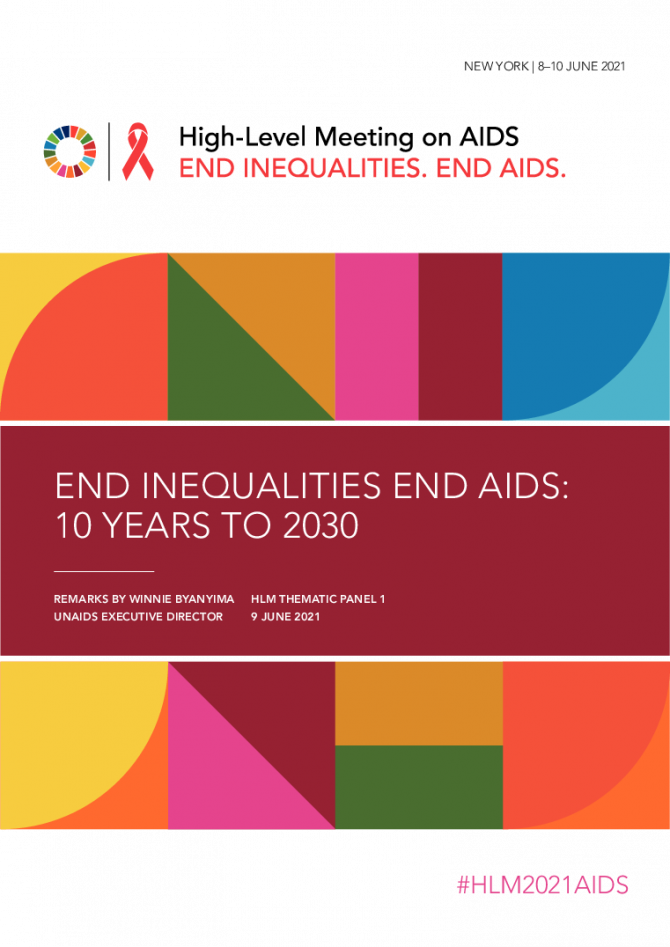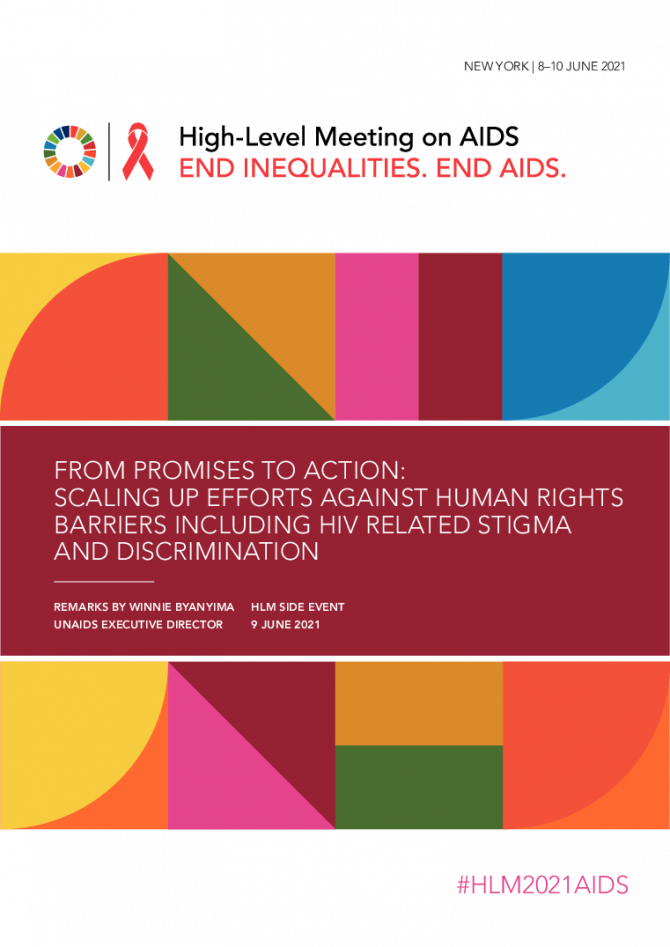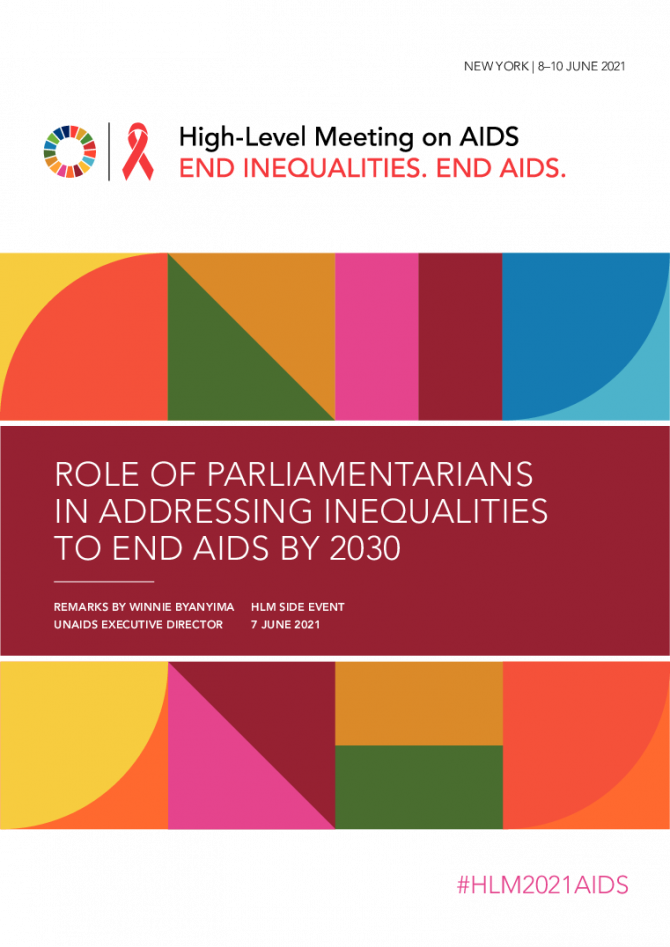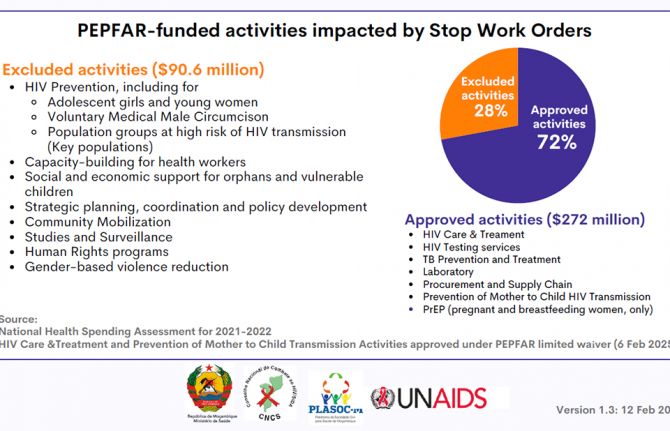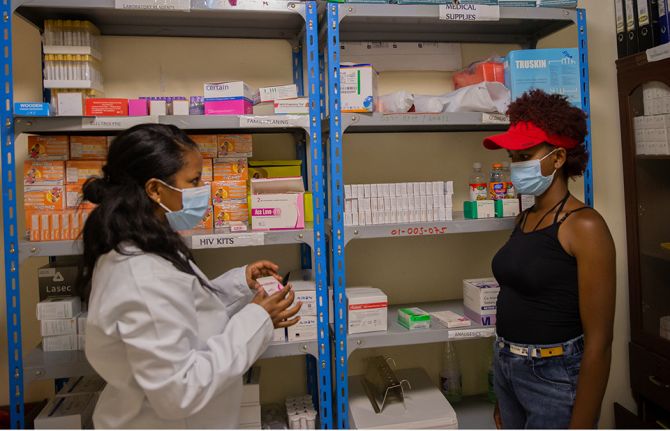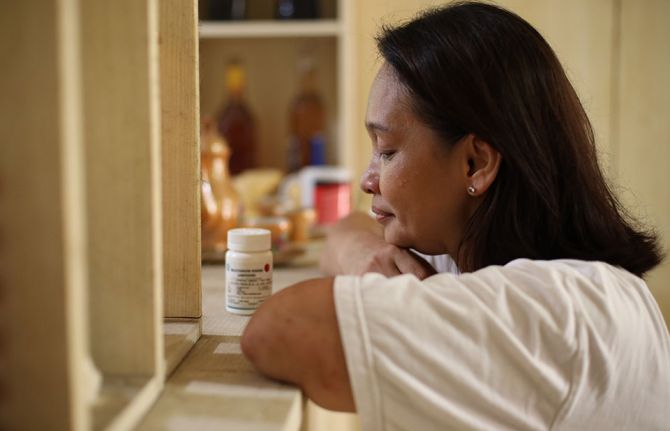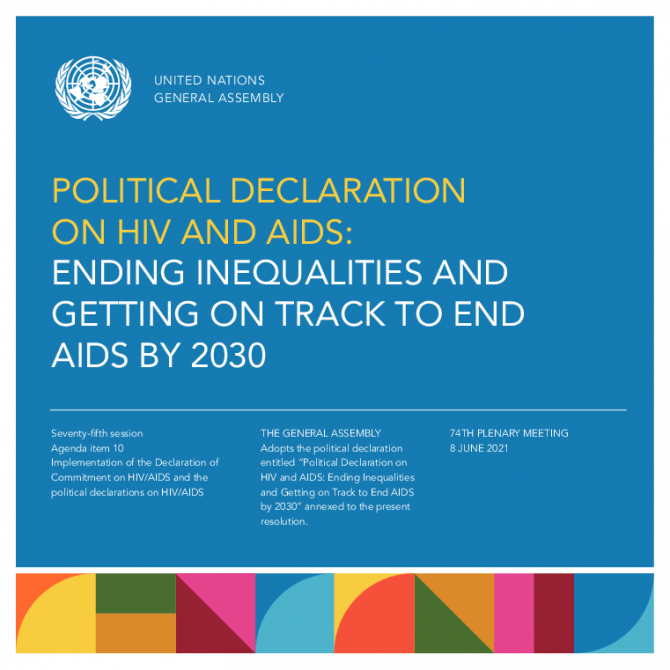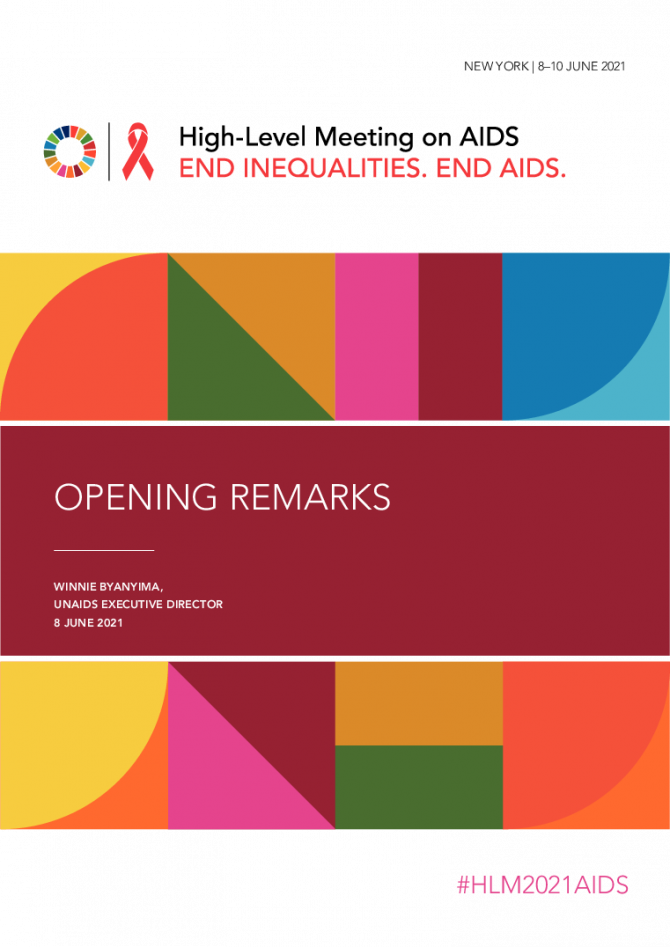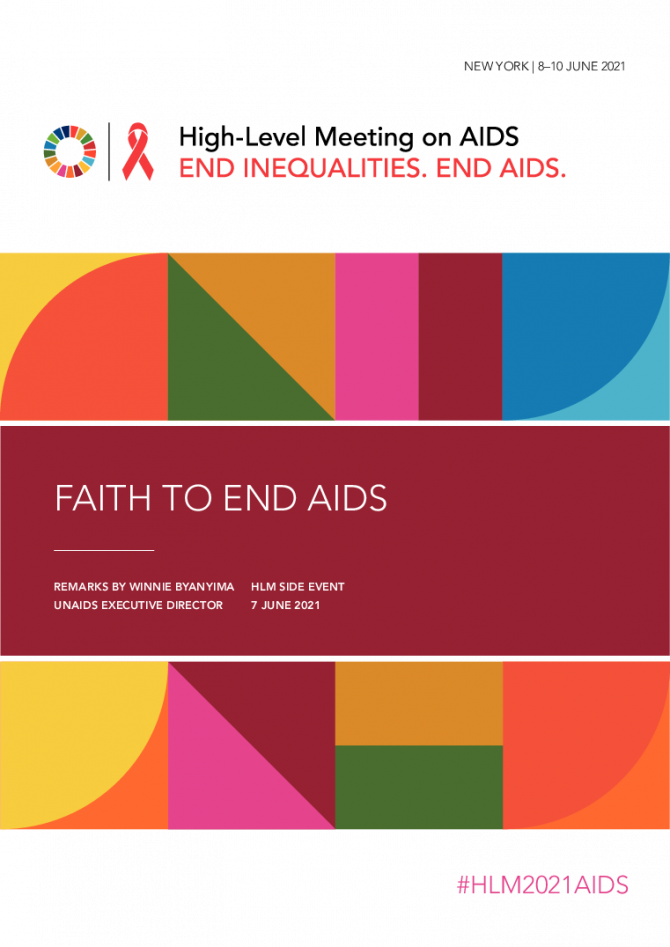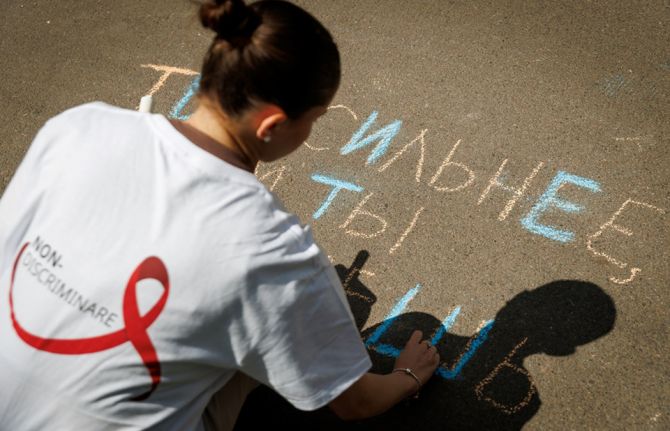
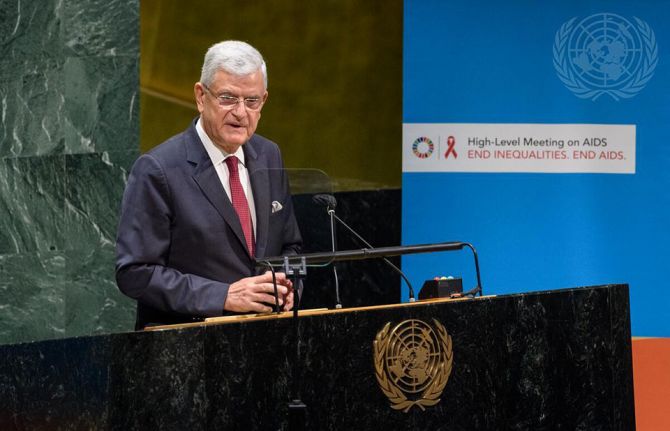
Press Release
New global pledge to end all inequalities faced by communities and people affected by HIV towards ending AIDS
08 June 2021 08 June 2021World leaders agree to reduce the annual number of new HIV infections to under 370 000 and AIDS-related deaths to 250 000, eliminate new HIV infections among children, end paediatric AIDS and eliminate all forms of HIV-related discrimination by 2025. They also committed to providing life-saving HIV treatment to 34 million people by 2025.
NEW YORK, 8 June 2021—United Nations Member States adopted a set of new and ambitious targets in a political declaration at the United Nations General Assembly High-Level Meeting on AIDS, taking place in New York, United States of America. If the international community reaches the targets, 3.6 million new HIV-infections and 1.7 million AIDS-related deaths will be prevented by 2030.
The political declaration calls on countries to provide 95% of all people at risk of acquiring HIV within all epidemiologically relevant groups, age groups and geographic settings with access to people-centred and effective HIV combination prevention options. It also calls on countries to ensure that 95% of people living with HIV know their HIV status, 95% of people who know their status to be on HIV treatment and 95% of people on HIV treatment to be virally suppressed.
“In this Decade of Action, if we are to deliver the 2030 Agenda for Sustainable Development all Member States must recommit to ending the AIDS epidemic by 2030,” said Volkan Bozkir, the President of the United Nations General Assembly.
“To end AIDS, we need to end the intersecting injustices that drive new HIV infections and prevent people from accessing services,” said Amina J. Mohammed, Deputy Secretary-General of the United Nations.
The political declaration notes with concern that key populations—gay men and other men who have sex with men, sex workers, people who inject drugs, transgender people and people in prisons and closed settings—are more likely to be exposed to HIV and face violence, stigma, discrimination and laws that restrict their movement or access to services. Member States agreed to a target of ensuring that less than 10% of countries have restrictive legal and policy frameworks that lead to the denial or limitation of access to services by 2025. They also committed to ensure that less than 10% of people living with, at risk of or affected by HIV face stigma and discrimination by 2025, including by leveraging the concept of undetectable = untransmittable (people living with HIV who have achieved viral suppression do not transmit HIV).
“I would like to thank Member States. They have adopted an ambitious political declaration to get the world back on track to ending the AIDS pandemic that has ravaged communities for 40 years,” said Winnie Byanyima, the UNAIDS Executive Director.
Expressing concern at the number of new HIV infections among adolescents, especially in sub-Saharan Africa, a commitment was made to reduce the number of new HIV infections among adolescent girls and young women to below 50 000 by 2025. Member States committed to eliminate all forms of sexual and gender-based violence, including intimate partner violence, by adopting and enforcing laws that address the multiple and intersecting forms of discrimination and violence faced by women living with, at risk of and affected by HIV. They pledged to reduce to no more than 10% the number of women, girls and people affected by HIV who experience gender-based inequalities and sexual and gender-based violence by 2025. In addition, commitments were made to ensure that all women can exercise their right to sexuality, including their sexual and reproductive health, free of coercion, discrimination and violence.
Countries were also urged to use national epidemiological data to identify other priority populations who are at higher risk of exposure to HIV, which may include people with disabilities, ethnic and racial minorities, indigenous peoples, local communities, people living in poverty, migrants, refugees, internally displaced people, men and women in uniform and people in humanitarian emergencies and in conflict and post-conflict situations. Countries also committed to ensure that 95% of people living with, at risk of and affected by HIV are protected against pandemics, including COVID-19.
“The stark inequalities exposed by the colliding pandemics of HIV and COVID-19 are a wake-up call for the world to prioritize and invest fully in realizing the human right to health for all without discrimination,” said Ms Byanyima.
Member States also committed to increase and fully fund the AIDS response. They agreed to invest US$ 29 billion annually by 2025 in low- and middle-income countries. This includes investing at least US$ 3.1 billion towards societal enablers, including the protection of human rights, reduction of stigma and discrimination and law reform. They also committed to include peer-led HIV service delivery, including through social contracting and other public funding mechanisms.
Calling for expanding access to the latest technologies for tuberculosis (TB) prevention, screening, diagnosis, treatment and vaccination, Member States agreed to ensure that 90% of people living with HIV receive preventive treatment for TB and reduce AIDS-related TB deaths by 80% by 2025. Countries also committed to ensure the global accessibility, availability and affordability of safe, effective and quality-assured medicines, including generics, vaccines, diagnostics and other health technologies to prevent, diagnose and treat HIV infection, its coinfections and other comorbidities through the use of existing flexibilities under the Agreement on Trade-Related Aspects of Intellectual Property Rights (TRIPS) and ensure that intellectual property rights provisions in trade agreements do not undermine the existing flexibilities as outlined in the Doha Declaration on the TRIPS Agreement and Public Health.
“The AIDS response is still leaving millions behind—LGBTI people, sex workers, people who use drugs, migrants and prisoners, teenagers, young people, women and children—who also deserve an ordinary life, with the same rights and dignity enjoyed by most people in this room,” said Yana Panfilova, a woman living with HIV and member of the Global Network of People Living with HIV.
The high-level meeting is being attended in-person and virtually by heads of state and government, ministers and delegates in New York, people living with HIV, civil society organizations, key populations and communities affected by HIV, international organizations, scientists and researchers and the private sector. UNAIDS supported regional consultations and the participation of civil society in the high-level meeting. Civil society organizations called on Member States to adopt a stronger resolution.
“While we have made some significant progress as a global community, we are still missing the mark and people are paying the price with their lives. There’s one single reason we are missing our goal: it’s inequality,” said Charlize Theron, Founder of the Charlize Theron Africa Outreach Project and a United Nations Messenger of Peace.
Member States also committed to support and leverage the 25 years of experience and expertise of the Joint United Nations Programme on HIV/AIDS (UNAIDS) and committed to fully fund the programme so that it can continue to lead global efforts against AIDS and support efforts for pandemic preparedness and global health.
In accordance with the Global AIDS Strategy 2021–2026: End Inequalities, End AIDS, adopted by consensus on 25 March 2021 by the UNAIDS Programme Coordinating Board, as well as the report of the United Nations Secretary-General, Addressing Inequalities and Getting Back on Track to End AIDS by 2030, issued on 31 March 2021, UNAIDS would have welcomed even stronger commitments on comprehensive sexuality education, sexual and reproductive health and rights, and sexual orientation and gender identity, unqualified acceptance of evidence-based HIV prevention options, such as harm reduction, a call for the decriminalization of the transmission of HIV, sex work, drug use and laws that criminalize same-sex sexual relationships and further flexibilization of intellectual property rules for access to life-saving medicines, vaccines and technologies.
In 2020, 27.4 million of the 37.6 million people living with HIV were on treatment, up from just 7.8 million in 2010. The roll-out of affordable, quality treatment is estimated to have averted 16.2 million deaths since 2001. AIDS-related deaths have fallen by 43% since 2010, to 690 000 in 2020. Progress in reducing new HIV infections has also been made, but has been markedly slower—a 30% reduction since 2010, with 1.5 million people newly infected with the virus in 2020, compared to 2.1 million in 2010.
UNAIDS
The Joint United Nations Programme on HIV/AIDS (UNAIDS) leads and inspires the world to achieve its shared vision of zero new HIV infections, zero discrimination and zero AIDS-related deaths. UNAIDS unites the efforts of 11 UN organizations—UNHCR, UNICEF, WFP, UNDP, UNFPA, UNODC, UN Women, ILO, UNESCO, WHO and the World Bank—and works closely with global and national partners towards ending the AIDS epidemic by 2030 as part of the Sustainable Development Goals. Learn more at unaids.org and connect with us on Facebook, Twitter, Instagram and YouTube.
Contact
UNAIDS GenevaSophie Barton-Knott
tel. +41 79 514 68 96
bartonknotts@unaids.org
UNAIDS Media
tel. +41 22 791 4237
communications@unaids.org
Watch Winnie Byanyima's full speech

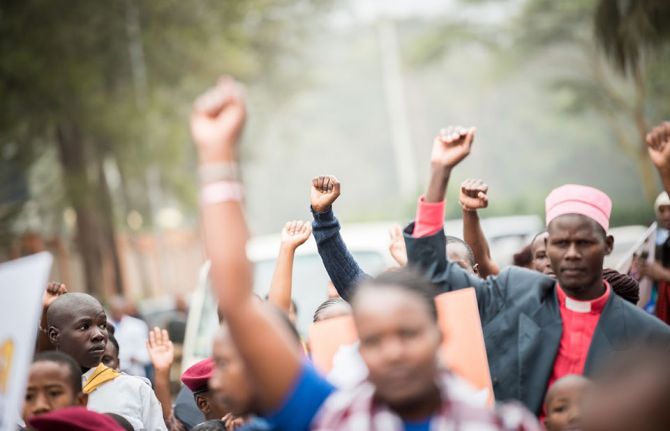
Feature Story
Faith2EndAIDS, Faith2EndInequality
07 June 2021
07 June 2021 07 June 2021Around 300 faith leaders and representatives of faith-based organizations met on 7 June in an online event, Faith2EndAIDS, Faith2EndInequality, on the sidelines of the United Nations High-Level Meeting on Ending AIDS.
Sharing lessons learned by faith-based organizations and faith communities in addressing stigma and discrimination, promoting human rights and increasing access to HIV services, the participants also explored the main areas of action in the political declaration on AIDS and the particular role of faith responses in implementing the commitments.
Practical examples were shared of faith-motivated programmes that increase access for people affected by inequalities, such as programmes for migrants and children. The participants emphasized the critical role that faith responses can play in mitigating stigma.
A key focus going forward is the 12 Million Campaign, where faith leaders, individuals and communities of faith commit to key actions that could promote access to HIV services by the 12 million people who are living with HIV who still do not have quality and consistent HIV treatment, care and support.
The active discussions in the chat box reflected the enthusiasm and commitment of faith communities and people of faith to play a meaningful role in ending AIDS and ending the inequalities that drive the pandemic.
Quotes
“We stand together firmly against the use of faith as an excuse to discriminate and stigmatize people living with HIV and key populations. We proudly recognize the positive results of our partnership and your recent frontline activities in addressing HIV-related discrimination, acting against gender-based violence and bringing quality care and support to all people living with HIV, including in humanitarian settings. Now is not the time to drop the ball on HIV.”
“We have not been able to respond to HIV without you and we will never be able to do it without you ... You have been invaluable partners in fighting HIV around the world. Faith-based organizations have been, are and will be crucial in responding to HIV.”
“The political declaration on HIV and AIDS urges the world to address the inequalities that are slowing progress, through bold political leadership that challenges and addresses the root causes of vulnerability to HIV.”
Documents
Political Declaration on HIV and AIDS: Ending Inequalities and Getting on Track to End AIDS by 2030
09 June 2021
United Nations Member States adopted this political declaration at the United Nations General Assembly High-Level Meeting on AIDS, taking place in New York, United States of America. If the international community reaches the targets, 3.6 million new HIV-infections and 1.7 million AIDS-related deaths will be prevented by 2030. Read press release. Read the official version of this document. This document is also available in Arabic and Chinese

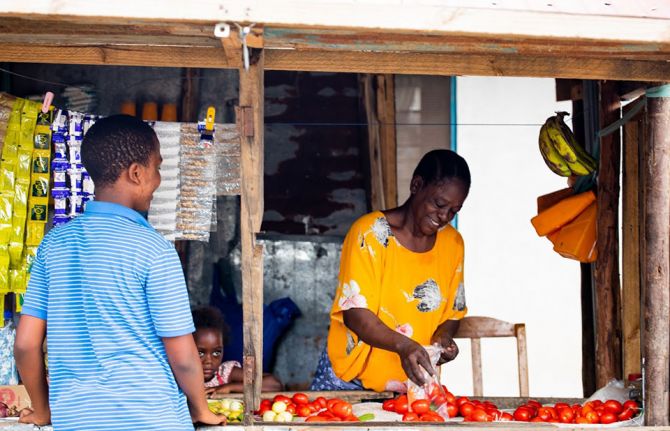
Feature Story
Strengthening national social protection systems
08 June 2021
08 June 2021 08 June 2021Many factors in society, including poverty, stigma, discrimination and persistent gender and socioeconomic inequalities, influence the health of individuals and communities, the participants heard at a side event at the United Nations High-Level Meeting on AIDS, being held in New York and online from 8 to 10 June.
At the event, Strengthening national social protection systems to adequately include people living with, at risk of, or affected by HIV to fast-track ending AIDS, speakers pointed out that it is at the intersections of multiple inequalities that the most vulnerable people lie. Compounding vulnerabilities hit the most marginalized and left behind people, and COVID-19 has brought those inequalities to the forefront.
The event highlighted promising country experiences. It showcased innovative approaches in enhancing access to social protection by people living with, at risk of and affected by HIV and brought together high-level representatives of governments, civil society, donors and academia to accelerate joint programming of HIV and social protection programmes to respond to COVID-19 and end AIDS by 2030.
The new global AIDS strategy aims to reduce the inequalities that drive the AIDS epidemic and acknowledges social protection’s central role in that. Social protection has the power to address the social and economic drivers of the HIV epidemic and to break down the barriers that people face in accessing HIV services. Social protection comprises public and private action to reduce risk, poverty and inequality, such as social safety nets, social security and labour market policies. It includes education, nutrition, housing, health and other social services.
Quotes
“Social protection systems are leaving behind people living with HIV; key populations are further left behind. This situation is completely unacceptable and is preventable. The UNAIDS Joint Programme knows how to reach people living with HIV and key populations with social protection services, including cash transfers.”
“The HIV response must focus on supporting the whole person and not only treating the patient. Social protection’s role in the global AIDS response needs to be given the same level of importance and relevance as testing and treatment.”
“Widespread state-sponsored homophobia and transphobia is a major obstacle for the LGBTQ community to access social protection services.”
“The Global Fund’s funding focuses on social protection going beyond cash or social transfers, promotes economic empowerment for key and vulnerable populations and addresses stigma and discrimination in accessing social health insurance.”
Our work

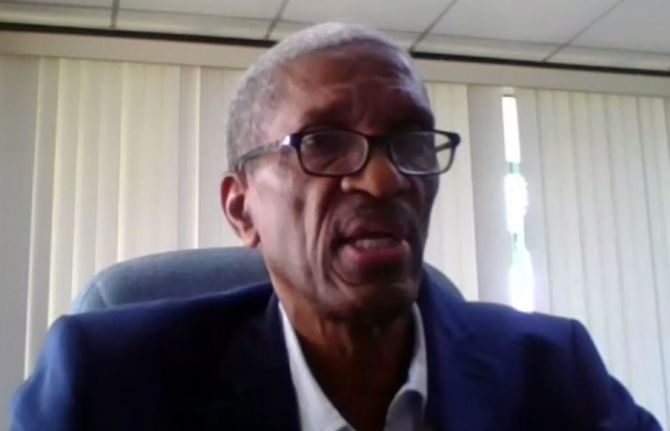
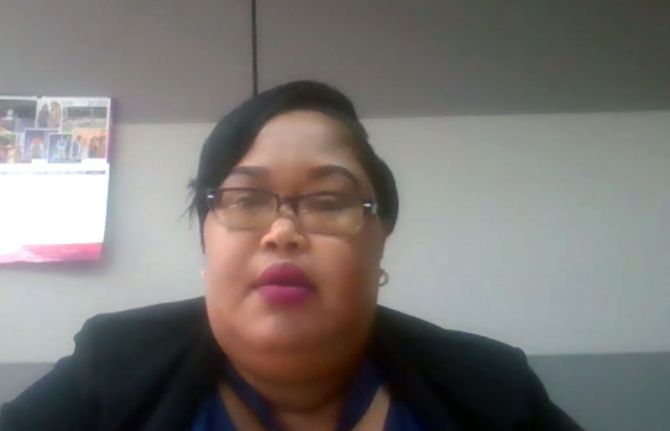
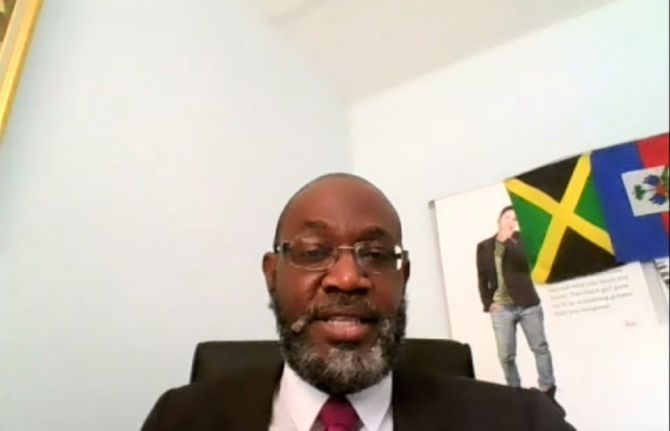
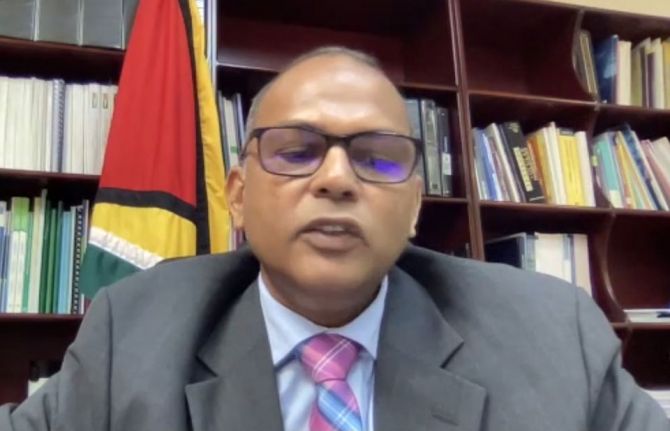
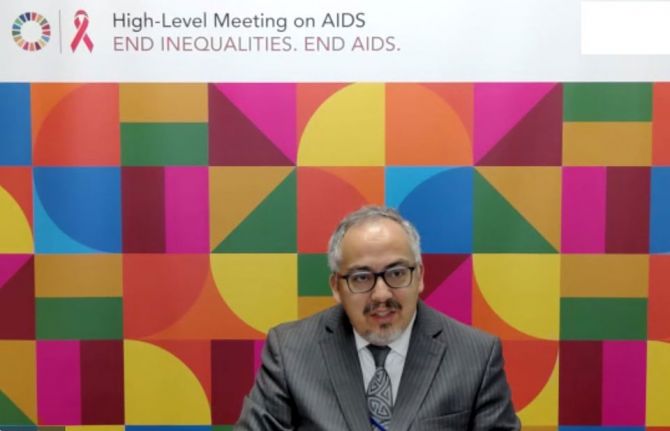
Feature Story
Caribbean stakeholders call for focus on key populations and community-led approaches to HIV and COVID-19
08 June 2021
08 June 2021 08 June 2021Caribbean partners from governments, civil society and the development community met on 7 June to discuss regional priorities for the 2021 United Nations High-Level Meeting on AIDS and its resulting political declaration. The virtual Caribbean Caucus was hosted by the Pan Caribbean Partnership against HIV/AIDS (PANCAP) and moderated by the Caribbean Community (CARICOM) Assistant Secretary-General, Douglas Slater.
The PANCAP Director, Rosmond Adams, noted that the Caribbean has made significant progress in key aspects of the HIV response. Eight countries and territories have been validated by the World Health Organization for eliminating vertical HIV and syphilis transmission. And between 2010 and 2020, AIDS-related deaths in the region fell by half (51%).
But to get on track to end AIDS by 2030, he said Caribbean countries must step up the pace around prevention, testing, treatment, care and ending stigma and discrimination. By 2020, 82% of people living with HIV in the region were diagnosed. Two thirds (67%) of all people living with HIV were on treatment and 59% were virally suppressed.
While new HIV infections have fallen by 28% since 2010, the rate of decline is too slow. Overall, members of key population communities and their partners accounted for 60% of new HIV infections in 2020. Around one third of new HIV infections were among young people aged 15–24 years.
Speaking on behalf of the Caribbean Regional Network of People Living with HIV (CRN+), Diana Weekes noted that key structural barriers continue to block access to HIV prevention, treatment and care services. These include “stigma and discrimination … lack of privacy, breach of confidentiality and limited redress” when people’s rights have been violated. She noted that no country in the region has adopted the CARICOM model antidiscrimination legislation, which was developed almost a decade ago. CRN+ called for greater emphasis on policy and legislative changes as well as community-led responses to address these structural barriers.
Ivan Cruickshank, the Executive Director of the Caribbean Vulnerable Communities Coalition, pointed to regional data that show that HIV disproportionately affects key populations, including gay men and other men who have sex with men, transgender people, sex workers and people who use drugs.
“According to the latest UNAIDS report, nations with progressive laws and policies, as well as robust and inclusive health systems, have had the best HIV outcomes. We must therefore create inclusive societies in which people are confident in their ability to seek medical treatment and exercise their social and economic rights. We must go beyond declarations, to remove laws that continue to criminalize communities and limit young people’s access to sexual and reproductive health and rights,” Mr Cruickshank said.
The Guyana Health Minister and Caribbean representative on the UNAIDS Programme Coordinating Board, Frank Anthony, reaffirmed the region’s commitment to the HIV response, saying that “governments in the region stand ready to do their part in ending AIDS by 2030.”
He pointed to longstanding challenges in the region, such as “removing the legal obstacles that foster discriminatory practices” and “prevention sustainability.” But he also emphasized the new threat posed by COVID-19, noting that “finite financial resources had to be reprogrammed to meet these urgent demands.” He called for increased vaccine equity and a review of plans to transition countries in the region away from international HIV funding.
“We must use the platform available to us at this United Nations high-level meeting to ensure that we highlight our vulnerabilities to the HIV epidemic and the COVID-19 pandemic,” he said.
During discussions, civil society participants also emphasized the profound negative impact of COVID-19 containment measures on lives and livelihoods. They said there was an additional need for solutions to provide nutrition, mental health and financial support to people living with HIV and members of key population communities.
The Director of the UNAIDS New York Liaison Office, César Núñez, noted that in the response to both HIV and COVID-19, the role of communities is clear.
“The response must include a key role for civil society at the table when frameworks are being put together and implemented,” he said.
Mr Núñez ended by calling for CARICOM’s support in securing an ambitious, action-oriented and laser-focused political declaration.

